The thing that makes the MCAT so unique compared to other standardized exams is that a lot of the passages that you’ll be required to read are taken from scientific articles and journals containing a whole lot of information and experiments!
With this comes various different studies and research methods. The MCAT doesn’t require you to have a Master of Public Health or be an expert in epidemiology and biostatistics; understanding the basics should suffice, as we’ll explain to you in this chapter overview.
This chapter overview will cover the basics of various research designs and methods as well as some important statistical values to be aware of for the MCAT. Let’s get started!
Research Methodology and Statistics on the MCAT: What You Need to Know
Topics on research methodology and statistics will be tested primarily on the Bio/Biochem and Psych/Soc sections of the MCAT and can appear both as passage-based and fundamental discrete questions.
It’s tough to calculate how many different types of questions about research methodology and statistics will be on the MCAT as they’re tested rather indirectly as they’re incorporated into how the passage is written. In order to prevent us from getting too deep into these topics and wasting time, we’ll be adamant about focusing on the core principles!
Important Sub-Topics: Research Methodology and Statistics
At first, learning and distinguishing between these different research methods and different types of studies can be a little daunting — we think the best way to approach them is to take each type of study a step at a time and eventually list their commonalities and differences, as we’ll show.
1. Overview of the Types of Research Studies
Generally, research studies can be divided into 2 main categories: experimental and observational. Experimental studies are where clinical investigators actively introduce an external factor or variable into the experimental group (i.e. a drug) in order to see the changes the factor/variable causes in the experimental group compared to the control.
In contrast, observational studies have NO external manipulation by the researchers and instead use present/pre-existing data in order to draw scientific conclusions. They’re called observational because there’s no direct influence by the researcher — they simply observe the population and collect data without any direct intervention. Check out the figure below for the main ones we’ll be covering!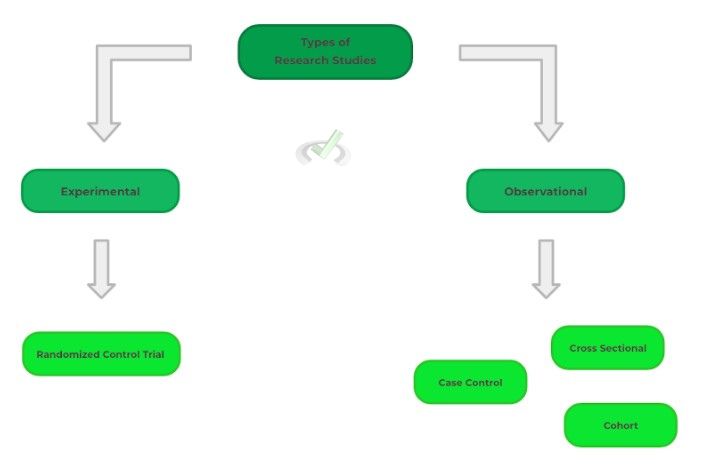
When categorizing these types of studies in regards to the strength of the evidence of the presented conclusion, randomized controlled trials are without a doubt the strongest because they allow for the most elimination of bias and other external factors when drawing a cause-effect relationship.
This is then followed by cohort studies, with case-control studies having the least amount of strength compared to the other 2. We didn’t include cross-sectional studies because these are more of a way to gauge what’s happening in the population, as we’ll discuss soon.
Additionally, note that while randomized control trials are really the gold standard to establish a causal relationship in clinical studies, they themselves are not shielded from various biases that can be introduced, compromising the quality of the study as we’ll also discuss later.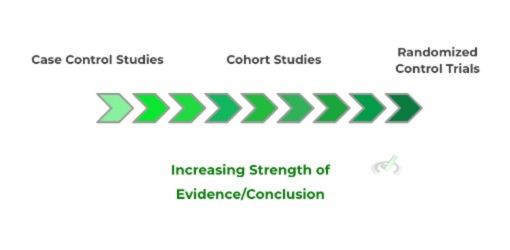
(Coming Soon!) Full Study Notes : Overview of the Types of Research
For more in-depth content review on the overview of the type of research, check out these detailed lesson notes created by top MCAT scorers.
2. Randomized Control Trials
As mentioned above, randomized control trials are a type of experimental study that — when compared to the other types of studies — has the highest strength in regard to the quality of the evidence/conclusion. In other words, RCTs are the strongest type of study when trying to establish a causal relationship (i.e. cause and effect).
A randomized control trial usually starts by gathering a group of people, usually with a common characteristic, and then randomly assigning them to either an experimental or control group.
The clinical investigators will then introduce some sort of external variable or factor to the experimental group, which will hopefully result in a statistically significant change in the outcomes between the experimental and control groups. Let’s look at a written example below!
A group of clinical researchers want to determine whether exercise can lead to decreased serum cholesterol levels in young adults. They recruited about 400 young adults ranging in age from 21 - 35 (group recruitment) and randomly assigned them to either an exercise group (experimental) or a nonexercise group (control). After the 8-month-long study, the researchers found that the experimental group did have a statistically significant decrease in cholesterol levels when compared to the control group.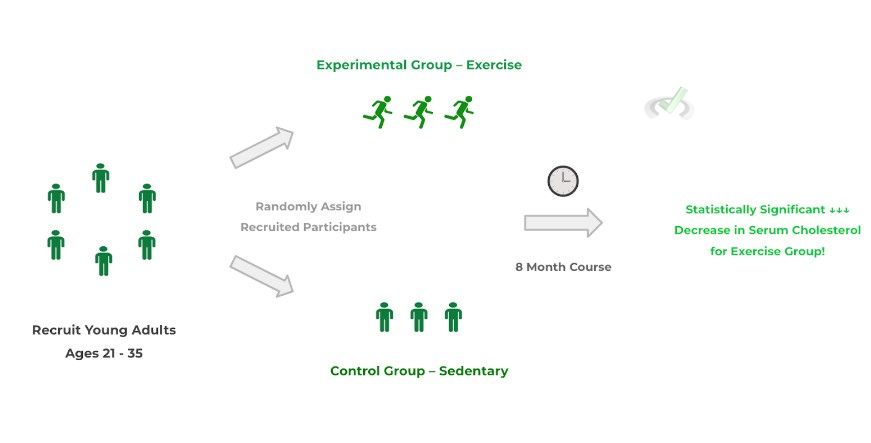
It’s highly important that the researchers randomly assign the recruited participants to either the experimental or control group, as a nonrandom assignment of participants can introduce various biases that can confound the drawn conclusions — this is where the “randomized” term comes from!
For example, say that the assignment of the adults wasn’t random and that the researchers actually selected individuals with a higher BMI to be assigned to the sedentary group. This could definitely weaken the drawn conclusions because those with a higher BMI would probably have significantly higher serum cholesterol to begin with, which could definitely lead to the skewing of the results.
In order to prevent this from happening in the first place, these RCTs also have to be controlled, meaning that the participants are recruited in a way where most share similar characteristics beforehand so that when conducting the RCT, the only real difference between the 2 groups are the experimental variables introduced by the investigators.
(Coming Soon!) Full Study Notes : Randomized Control Trials
For more in-depth content review on the randomized control trials and their unique characteristics, check out these detailed lesson notes created by top MCAT scorers.
3. Cohort v.s. Case-Control Studies
We decided to include these 2 types of studies together into one section because they tend to be a point of confusion since they’re pretty similar as both of them are types of observational studies — recall that observational studies are studies where the investigators simply “observe” and collect patient data without any direct intervention.
In cohort studies, we’re really trying to find a trend/association between some sort of exposure and seeing if it’s a risk factor leading to a specific outcome (oftentimes, disease).
Usually, the researchers will identify participants and arrange them into cohorts. Oftentimes, the 2 cohorts involve individuals who’ve been exposed to some risk factor and those who haven’t been exposed. The researchers then observe the outcomes of each cohort, often which is whether a disease occurred or not.
Additionally, there are 2 types of cohort studies that primarily differ in timing: a prospective and retrospective cohort study. In a prospective cohort study, we recruit participants and divide them into the exposed and unexposed groups AT THE PRESENT DAY/TIME. Then, we follow the groups going forward in the future and see if they develop a certain outcome.
A retrospective study is a little bit different where instead of finding participants and categorizing them in the present day, we actually have to look through PAST MEDICAL RECORDS in order to find individuals and categorize them based on their exposure status in the past. Then, we can look further into their medical records and follow them to the present day and see if they developed a certain outcome.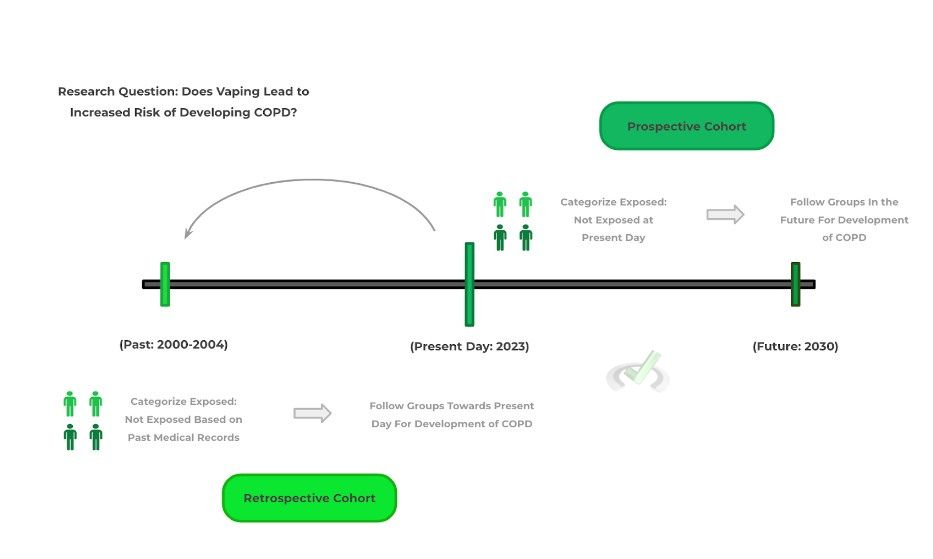
Hopefully, the way we designed the timeline with accompanying dates makes it a little easier to understand the difference between the 2 studies. When you view it in this way, it kinda looks like the retrospective cohort study is a prospective study just shifted towards the past!
One major point of confusion is differentiating between a retrospective cohort study and a case-control study because both studies are observational and retrospective in nature.
The main characteristic of a case-control study is that we categorize individuals into groups at the present day on the basis of whether or not they’ve DEVELOPED AN OUTCOME/DISEASE — in other words, we’re categorizing individuals in the present day based on those who’ve developed a case of the outcome (hence, the name case-control).
Then, we look towards the individual’s past medical and social history or interview the individual about their past to see if there may be any potential prior exposures that may have some sort of association. Look at the example below!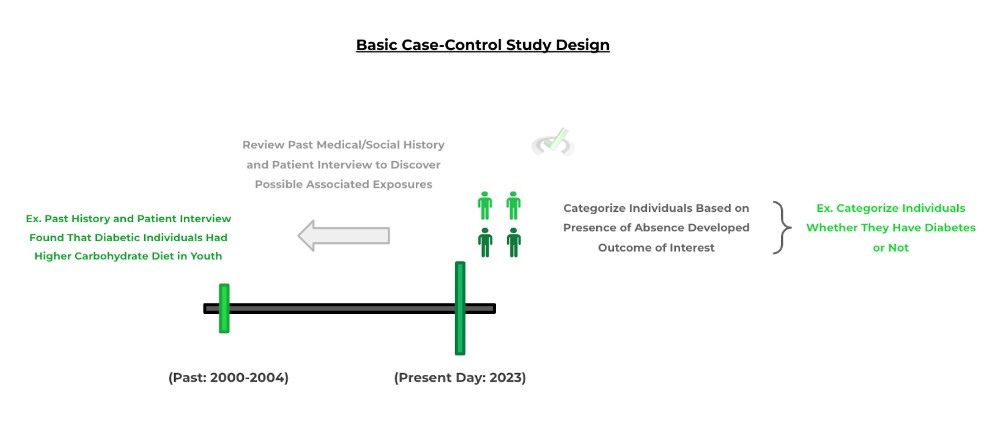
Contrast this to a retrospective cohort study where we go back in time to review the past medical records to first find the possible exposures/risk factors and then follow up for the possible development of an outcome of interest in the present day.
In a case-control study, it’s reversed: we start with a present-day developed outcome of interest and try to go back in time to find a possible exposure/risk factor. Take a look at the summarizing figure below!
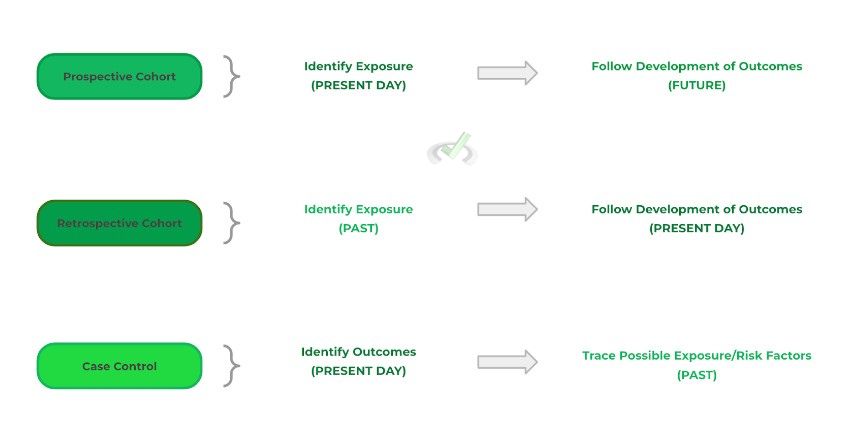
(Coming Soon!) Full Study Notes : Cohort v.s. Case- Control Studies
For more in-depth content review on the differences between cohort and case-control studies, check out these detailed lesson notes created by top MCAT scorers.
4. Cross-Sectional Studies
Lucky enough, cross sectional studies are fairly simple! In reality, they’re not so much a type of study and really are better thought of as a measure of “what’s going on” at the present time. Oftentimes, cross-sectional studies are used when you want to determine the prevalence of a disease or some other sort of outcome.
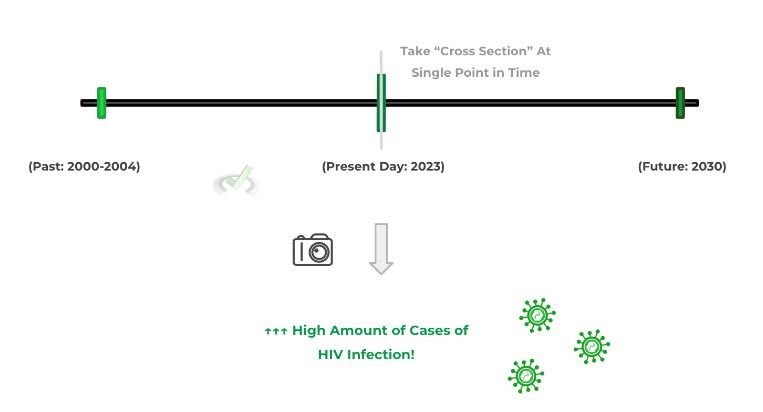
It gets its name as a cross-sectional study because we essentially take a “cross-section” at a single point in time and observe the prevalence (i.e. how many cases) of a disease/outcome of interest there are — again, it’s important to emphasize we’re doing this in a single point in time!
As shown above, with the icon above, you can also think of it or word it as rather a “snapshot” of what’s happening at a single point in time! From a cross-sectional study, we can maybe transition into other types of studies such as a case-control study — taking the example above, we can maybe make a case-control study identifying possible risk factors/exposures as to why the HIV cases are so high!
(Coming Soon!) Full Study Notes : Cross-Sectional Studies
For more in-depth content review on cross-sectional studies, check out these detailed lesson notes created by top MCAT scorers.
5. Confounding Factors and Statistical Significance
We’ll end our discussion about research methodology and statistics with some notes about how some concluded associations and cause-effect relationships may not be what they seem and actually may be tweaked in a way that kinda gives us a false illusion.
The drawn conclusions of a research study are confounded when there’s another factor that could affect the association or the cause-effect relationships that were found. In other words, we CANNOT say that (A) leads to (B) because there may be another factor (C) that’s somehow affecting the said relationship.
Oftentimes, confounding variables arise due to faulty and improper study designs. In addition, we usually characterized the effects of confounding variables on their effect on analysis, which results in a weakening of internal or external validity.
A loss of internal validity results when the confounding variable invalidates the relationship that was concluded/observed in the study. For example, suppose a study found that there was an association between individuals who use heavy blue light devices and the development of retinoblastoma.
However, upon further investigation, it’s found that over 60% of patients in the exposure group (i.e. heavy blue light device use) have a predisposed genetic mutation in the pRB gene, which also severely increases your risk of developing retinoblastoma.
As such, the internal validity is compromised because we don’t know whether the observed outcome of retinoblastoma is associated with the heavy blue light device use or the pRB gene mutation.
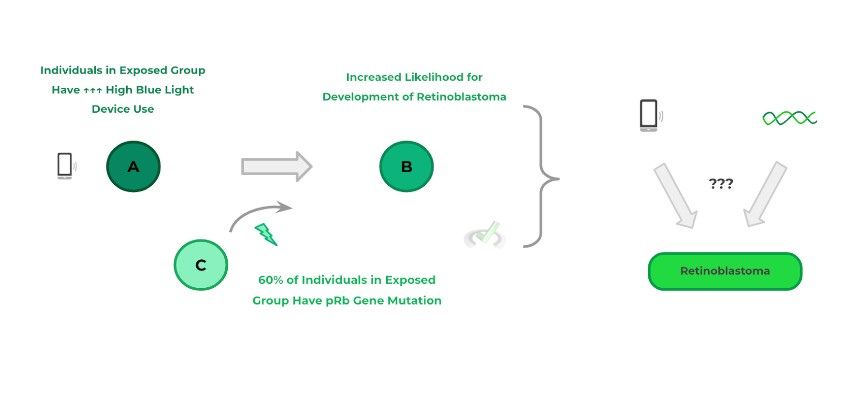
In the case of a loss of external validity, we see that the conclusions drawn by the study are sound and statistically significant (more on that later); however, the selection and the parameters of the study were so specific and narrow that the results of the study are inapplicable to real-world scenarios.
Another way to think about it is that we CANNOT apply the findings “externally” to the real world. Suppose a randomized clinical trial study was done, which found that a drug was statistically significant in increasing insulin sensitivity for diabetic individuals. However, the diabetic individuals selected for the RCT had a narrow age range from 21 to 25 years of age.
As a final topic of discussion, an important value to understand and really commit to memory is the p-value. We’ll go into much more detail about the definition and what p-values really mean — for now, just know that p-values can help us conclude whether the observed results are statistically significant or not.
When we say the results of a study are statistically significant, we basically say that the observed relationship between the dependent and independent variables is strong and that the association was not due to chance. The main relationships between the p-value (and committing to memory) are noted below:
For a more in depth discussion of , give this article a read!
(Coming Soon!) Full Study Notes : Confounding Factors and Statistical Significance
For more in-depth content review on how confounding variables can skew reported conclusions and the significance of the p-value, check out these detailed lesson notes created by top MCAT scorers.
Important Definitions and Key Terms
Below are some high yield definitions and key terms to refer to when reviewing concepts and ideas about social structure and stratification!
Term | Definition |
|---|---|
Experimental Studies | A type of study where the researchers directly introduce an external factor in order to see its effect on the experimental group |
Observational studies | A type of study where there is no external manipulation by the researchers; they simply observe and collect data from the study participants |
Randomized Control Trial | A type of experimental study where the investigators, after controlling for various factors in the selected participants, randomly assign the participants into an experimental and control group |
Cohort Studies | A type of observational study where investigators create an exposed/unexposed group and follow the groups to see for the development of an outcome of interest |
Case-Control Studies | A type of observational study where investigators first start with a group of people with an outcome of interest and look retrospectively to determine a possible predisposing risk factor/exposure |
Cross-Sectional Studies | A type of study which measures the prevalence of a certain outcome of interest/phenomena at a single point in time |
Confounding Variables | Elements of a research design which results in the invalidation of the drawn conclusions |
P Value | A statistical value which helps to determine whether an observed relationship in the study is strong and can be accepted |


 To help you achieve your goal MCAT score, we take turns hosting these
To help you achieve your goal MCAT score, we take turns hosting these